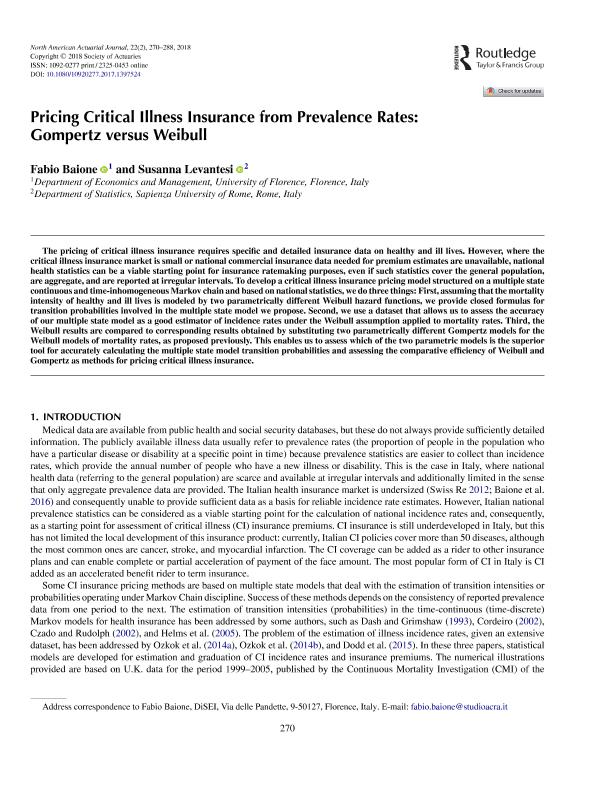Pricing critical illness insurance from prevalence rates : Gompertz versus Weibull

Contenido multimedia no disponible por derechos de autor o por acceso restringido. Contacte con la institución para más información.
| Tag | 1 | 2 | Value |
|---|---|---|---|
| LDR | 00000cab a2200000 4500 | ||
| 001 | MAP20180025754 | ||
| 003 | MAP | ||
| 005 | 20180830121814.0 | ||
| 008 | 180808e20180601usa|||p |0|||b|eng d | ||
| 040 | $aMAP$bspa$dMAP | ||
| 084 | $a6 | ||
| 100 | $0MAPA20180012044$aBaione, Fabio | ||
| 245 | 1 | 0 | $aPricing critical illness insurance from prevalence rates$b : Gompertz versus Weibull$cFabio Baione, Susanna Levantesi |
| 520 | $aThe pricing of critical illness insurance requires specific and detailed insurance data on healthy and ill lives. However, where the critical illness insurance market is small or national commercial insurance data needed for premium estimates are unavailable, national health statistics can be a viable starting point for insurance ratemaking purposes, even if such statistics cover the general population, are aggregate, and are reported at irregular intervals. To develop a critical illness insurance pricing model structured on a multiple state continuous and time-inhomogeneous Markov chain and based on national statistics, we do three things: First, assuming that the mortality intensity of healthy and ill lives is modeled by two parametrically different Weibull hazard functions, we provide closed formulas for transition probabilities involved in the multiple state model we propose. Second, we use a dataset that allows us to assess the accuracy of our multiple state model as a good estimator of incidence rates under the Weibull assumption applied to mortality rates. Third, the Weibull results are compared to corresponding results obtained by substituting two parametrically different Gompertz models for the Weibull models of mortality rates, as proposed previously. This enables us to assess which of the two parametric models is the superior tool for accurately calculating the multiple state model transition probabilities and assessing the comparative efficiency of Weibull and Gompertz as methods for pricing critical illness insurance | ||
| 650 | 4 | $0MAPA20080610333$aDistribución de Weibull | |
| 650 | 4 | $0MAPA20180012297$aModelo de Gompertz | |
| 650 | 4 | $0MAPA20080592042$aModelos matemáticos | |
| 650 | 4 | $0MAPA20080624941$aSeguro de enfermedades graves | |
| 650 | 4 | $0MAPA20080586294$aMercado de seguros | |
| 650 | 4 | $0MAPA20080576783$aModelo de Markov | |
| 650 | 4 | $0MAPA20080586447$aModelo estocástico | |
| 650 | 4 | $0MAPA20080592011$aModelos actuariales | |
| 650 | 4 | $0MAPA20080602437$aMatemática del seguro | |
| 700 | $0MAPA20120013445$aLevantesi, Susanna | ||
| 773 | 0 | $wMAP20077000239$tNorth American actuarial journal$dSchaumburg : Society of Actuaries, 1997-$x1092-0277$g04/06/2018 Tomo 22 Número 2 - 2018 , p. 270-288 |

